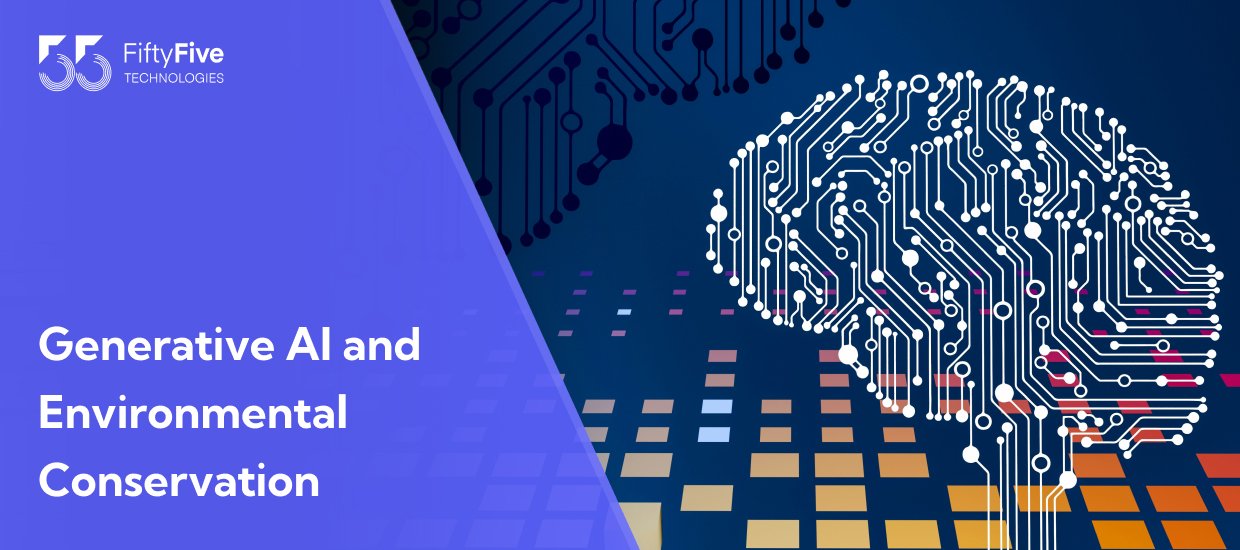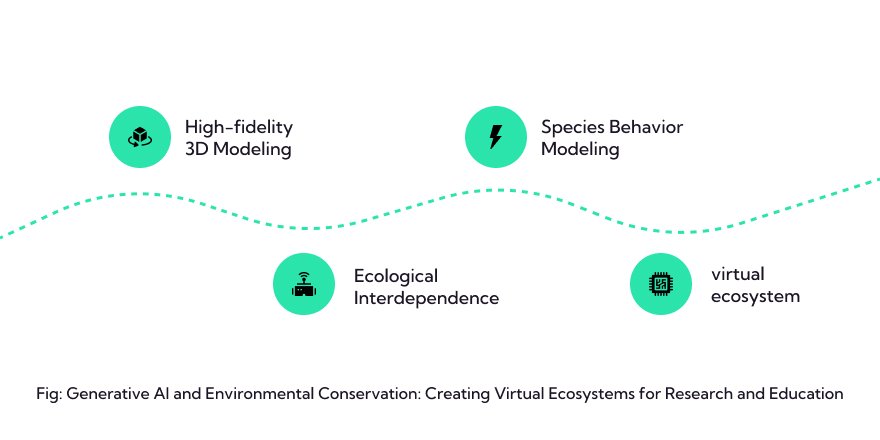Offices: Gurgaon, Jaipur, Indore, London, Dubai, Sweden
Generative AI and Environmental Conservation

Imagine a world where studying the intricate dance of a coral reef ecosystem or the delicate balance of a predator-prey relationship happens not in a fragile real-world environment, but within the immersive realm of a computer simulation. This isn’t science fiction; it’s the burgeoning reality of generative AI in environmental conservation.
Generative AI, a branch of artificial intelligence focused on creating entirely new data, is being harnessed to build virtual ecosystems – realistic, data-driven simulations of natural environments. These digital landscapes hold immense potential to revolutionize environmental research and education, allowing scientists to study complex ecological processes without disrupting real ecosystems and fostering a deeper understanding of the natural world for everyone.
Simulating the Symphony of Nature
Building a virtual ecosystem requires a symphony of technological advancements. FiftyFive Tech, a leading innovator in AI for environmental applications, is at the forefront of this movement. Their “TerraGenesis” platform utilizes a combination of techniques, including:
High-fidelity 3D Modeling: AI algorithms generate intricate 3D models of landscapes, incorporating data on topography, vegetation, and weather patterns. This creates a visually stunning and realistic digital environment.
Species Behavior Modeling: AI can analyze vast datasets on animal behavior to create realistic virtual lifeforms. These digital creatures can exhibit complex behaviors like hunting, foraging, and migration within the simulated ecosystem.
Ecological Interdependence: The heart of a virtual ecosystem lies in the simulated interactions between its various elements. Generative AI allows for the modeling of intricate food webs, predator-prey dynamics, and the impact of environmental changes on these relationships.
Unveiling the Secrets of Our Planet
These virtual worlds offer a unique research sandbox for scientists. Here are some ways AI-generated ecosystems are aiding environmental conservation:
Climate Change Impact Studies: By simulating different climate scenarios within the virtual ecosystem, scientists can predict the potential impact of rising temperatures, changing precipitation patterns, and extreme weather events on specific habitats and species. This can inform crucial conservation efforts.
Species Reintroduction Planning: Reintroducing endangered species into their natural habitat is a delicate task. Using virtual ecosystems, conservationists can simulate the reintroduction process and assess its feasibility, minimizing risks to the species and the existing ecosystem.
Habitat Restoration Optimization: Restoring damaged ecosystems is complex. AI simulations can help identify optimal planting strategies for vegetation restoration or predict the impact of introducing new species to a recovering habitat.

Case Studies: AI in Action
FiftyFive Tech’s TerraGenesis platform is already making waves in the conservation world. Here are two inspiring examples:
The Great Barrier Reef Rescue: Scientists are utilizing TerraGenesis to simulate the impact of climate change on the iconic Great Barrier Reef. These simulations are helping researchers develop strategies for coral reef restoration and identify areas most vulnerable to rising sea temperatures.
The Return of the Black-Footed Ferret: Once thought to be extinct, the black-footed ferret is making a comeback. But reintroducing them to their native grasslands requires careful planning. TerraGenesis simulations are helping researchers understand how changes in prey populations and competition with other species might affect the success of the reintroduction program.
Expert Opinions: A Glimpse into the Future
To gain a deeper understanding of the future of AI-powered virtual ecosystems, I spoke with Dr. Anya Chen, a leading environmental scientist, and Dr. Mark Davies, an expert in AI applications for sustainability.
Dr. Chen emphasizes the potential for virtual ecosystems to democratize environmental research: “These simulations make complex ecological processes accessible not just to seasoned researchers, but also to students and citizen scientists. This can foster broader participation in conservation efforts.”
Dr. Davies highlights the continuous evolution of the technology: “As AI continues to develop, we can expect even more sophisticated virtual ecosystems that incorporate real-time data from satellite imagery and sensor networks. This will allow for near-real-time simulations, offering unparalleled insights into the changing dynamics of real-world environments.”
The Road Ahead: A Sustainable Future
The marriage of generative AI and environmental conservation is still in its nascent stages, but the potential is undeniable. As virtual ecosystems become more detailed and sophisticated, they have the power to transform how we study and protect our planet. By offering a safe space to experiment, predict, and optimize conservation strategies, AI-powered simulations can pave the way for a more sustainable future for our planet.
Join the Conversation
Generative AI for environmental conservation is a rapidly evolving field. What are your thoughts on this innovative application? Share your ideas in the comments below and let’s keep the conversation going!
Recent Posts
Wish to live a culture beyond tech ?
Quick links
Contact
-
INDIA
-
-
-
37B - Thinkvalley , Sector 32 - Gurgaon Haryana - 122002
-
J-2, Jhalana Institutional Area, Jhalana Doongri, Jaipur, Rajasthan 302004
-
Incuspaze Co-Work, 208, 2nd Floor, Apollo Premier, Vijaynagar Square, Indore (MP) 452010
Locations
-
UK
-
-
-
Wework, 33 Queen Street, London, England, EC4R 1AP
-
FZCO IFZA Business Park, Dubai Digital Park, Dubai Silicon Oasis, Dubai, United Arab Emirates
-
Herrgardsvagen 12 A 135 53 TYRESO Sweden
© All Copyright 2022 by FIFTYFIVE TECHNOLOGIES


